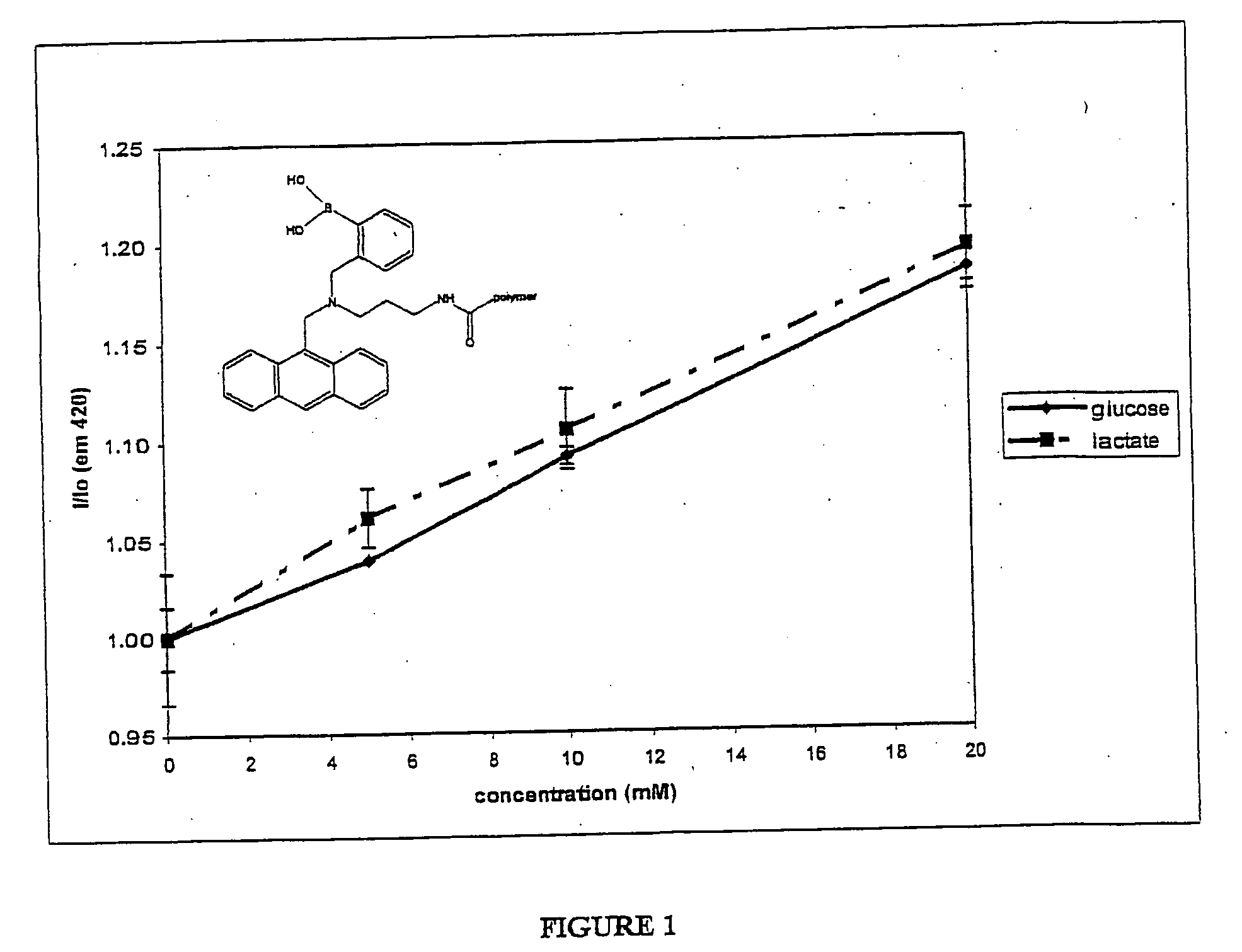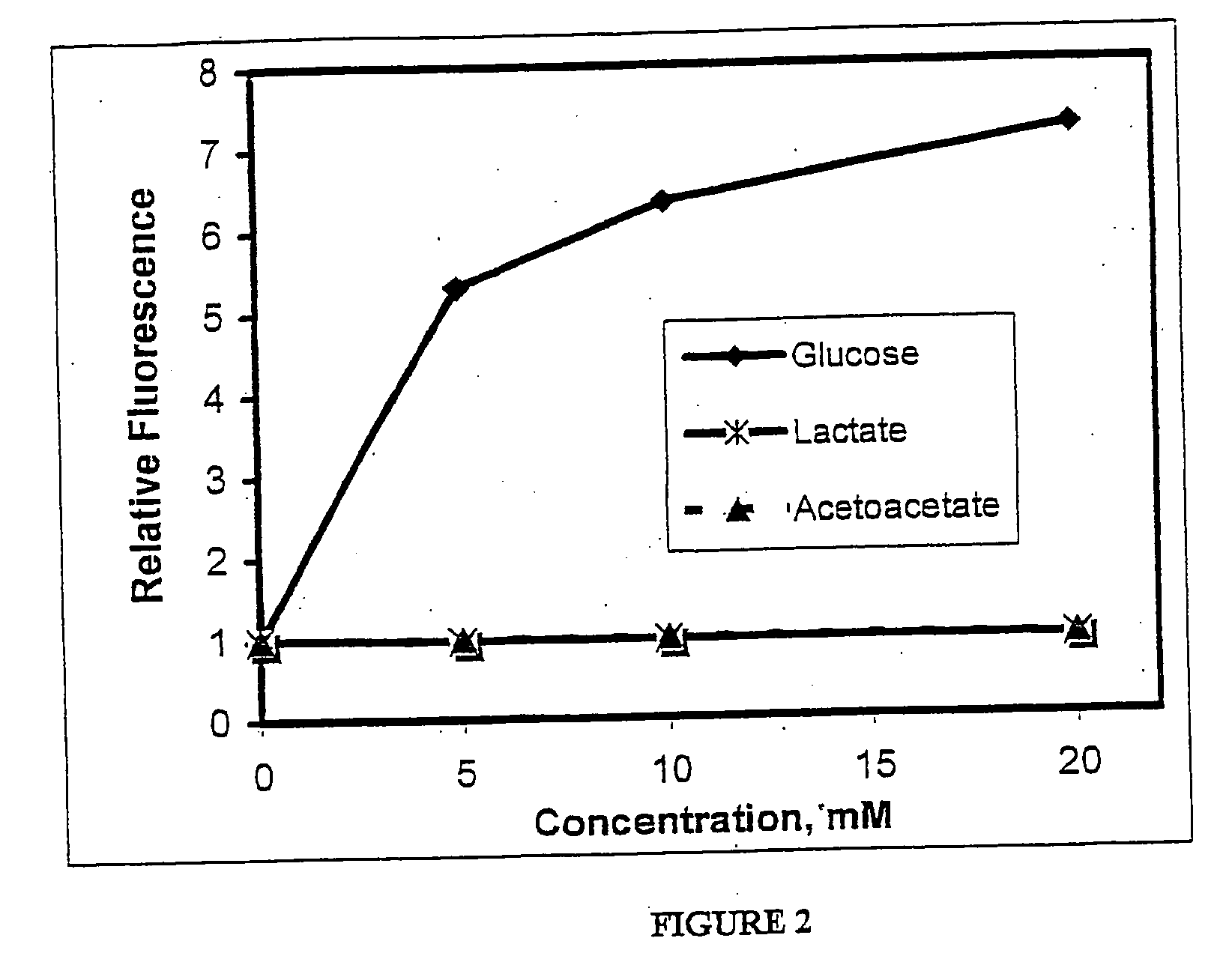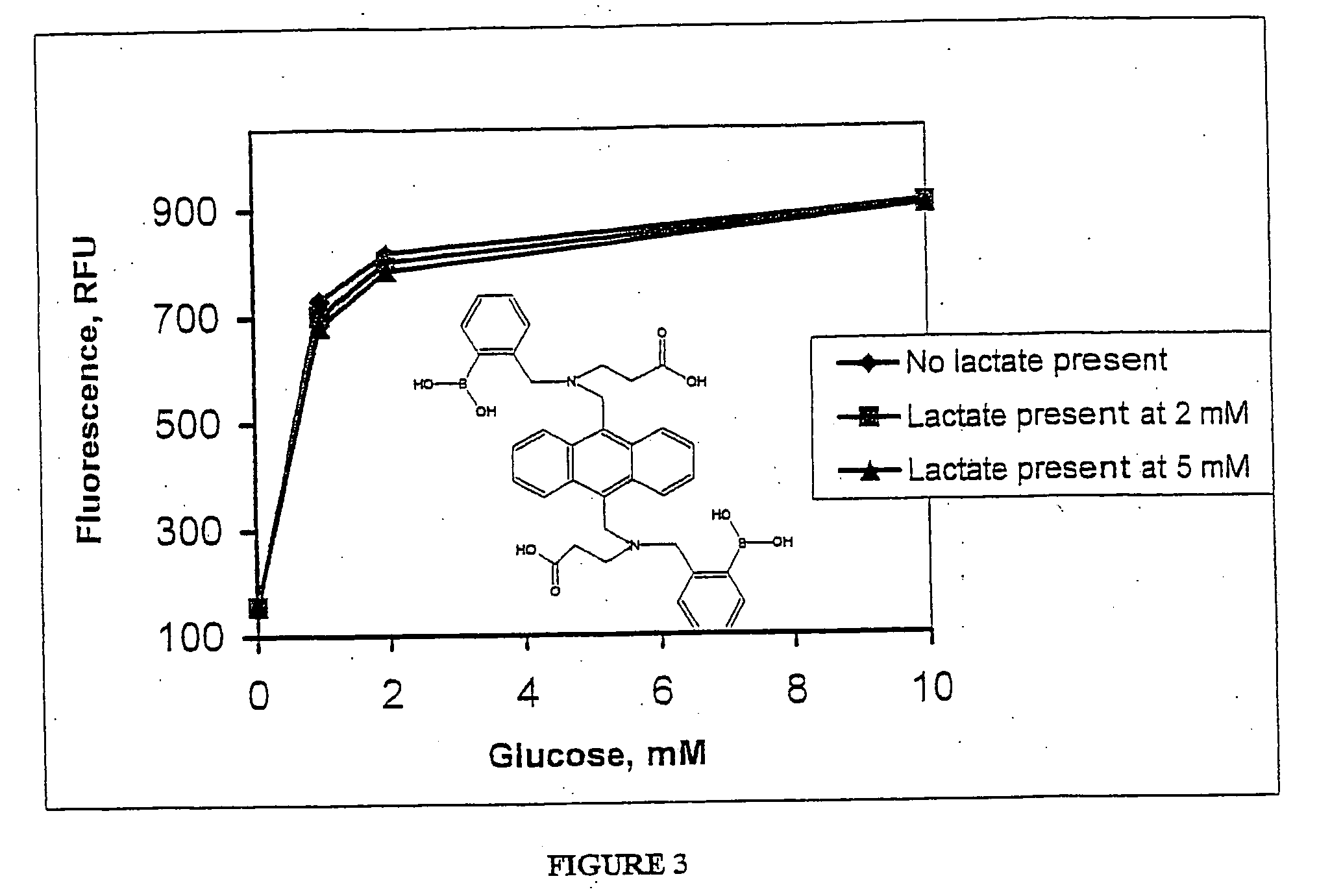Detection of glucose in solutions also containing an alpha-hydroxy acid or a beta-diketone
- Summary
- Abstract
- Description
- Claims
- Application Information
AI Technical Summary
Benefits of technology
Problems solved by technology
Method used
Image
Examples
example 1
Water Soluble Copolymer of Anthracene Derivative and MAPTAC
I. Synthesis of Mono-Boronate-Anthracene Indicator Co-Polymerized in Water-Soluble Polymer:
A. 9-[3-(methacrylamido)propylamino]methylanthracene
To a suspension of N-(3-aminopropyl)methacrylamide hydrochloride salt (11.82 g, 66.0 mmole, 3.0 equiv.) and DBMP (10 mg as inhibitor) in 250 mL CHCl3 at 0° C. was added dropwise DIEA (18.5 g, 25.0 mL, 144 mmole, 6.5 equiv.) over a 20 min period. The mixture was allowed to warm to 25° C. and then recooled to 0° C. To the cooled mixture was added dropwise a solution of 9-chloromethylanthracene (5.0 g, 22 mmole) in CHCl3 (100 mL) over a 1 hour period. The mixture was subsequently stirred at 25° C. for 1 hour, 50° C. for 12 hours and then 70° C. for 2 hours. At this time, the mixture was washed with 4×60 mL portions of water, and the combined aqueous layers were extracted with CH2Cl2. The combined organic extracts were dried over anhydrous Na2SO4, decanted and concentrated in vacuo...
example 2
Modulation of Bis-Boronate-Indicator Covalently Attached to Water-Soluble Polymer by Glucose and Potential Physiological Interferences.
I. Synthesis of Single-Methacrylate Monomer of Bis-Boronate-Anthracene Indicator
A. 9,10-bis[[2-(2-hydroxyethoxy)ethylamino]methyl]-anthracene.
To a solution of 2-(2-aminoethoxy)ethanol (31.4 g, 30.0 mL, 299 mmole, 20.9 equiv.) in 40 mL CHCl3 at 23° C. was added 9,10-bis(chloromethyl)anthracene (3.94 g, 14.3 mmole). The solution was stirred in the dark for 67 hours. At this time, added 100 mL CH2Cl2 and washed with 1×50 mL and 2×100 mL portions of NaHCO3 (saturated aqueous solution). The organic extract was dried over anhydrous Na2SO4, filtered and concentrated to yield 4.67 g (79%) of a yellow powder. Product (˜85% pure by RP-HPLC) was carried on as is.
HPLC conditions: HP 1100 HPLC chromatograph, Vydac 201TP 10×250 mm column, 0.100 mL injection, 2 mL / min, 370 nm detection, A=water (0.1% HFBA) and B=MeCN (0.1% HFBA), gradient 10% B 2 min, 10-...
example 3
Effect of Lactate in Solution on the Dose Response Effect of Glucose on the Fluorescence of Bis-Boronate-Anthracene Indicator
A. 9,10-bis[[2-(tert-butoxycarbonyl)ethylamino]methyl]-anthracene.
A solution of β-alanine tert-butyl ester hydrochloride (3.06 g, 16.8 mmole, 5.09 equiv.), DIEA (4.27 g, 5.75 mL, 33.0 mmole, 10.00 equiv.) and 9,10-bis(chloromethyl)anthracene (0.910 g, 3.31 mmole) in 75 mL CHCl3 at 23° C. was stirred in the dark for 93 hours. At this time, the solution was filtered and washed with 1×40 mL and 2×60 mL portions of NaHCO3 (saturated aqueous solution). The organic extract was dried over anhydrous Na2SO4, filtered and concentrated to yield a crude yellow solid. The residue was purified by silica gel column chromatography (30 g gravity grade gel, 0-3% CH3OH / CH2Cl2) to yield 1.06 g (65%) of a viscous yellow-orange. Product was carried on as is.
TLC: Merck silica gel 60 plates, Rf 0.33 with 95 / 5 CH2Cl2 / CH3OH, see with UV (254 / 366).
B. 9,10-bis[N-[2-(5,5-dimeth...
PUM
 Login to View More
Login to View More Abstract
Description
Claims
Application Information
 Login to View More
Login to View More - R&D
- Intellectual Property
- Life Sciences
- Materials
- Tech Scout
- Unparalleled Data Quality
- Higher Quality Content
- 60% Fewer Hallucinations
Browse by: Latest US Patents, China's latest patents, Technical Efficacy Thesaurus, Application Domain, Technology Topic, Popular Technical Reports.
© 2025 PatSnap. All rights reserved.Legal|Privacy policy|Modern Slavery Act Transparency Statement|Sitemap|About US| Contact US: help@patsnap.com



